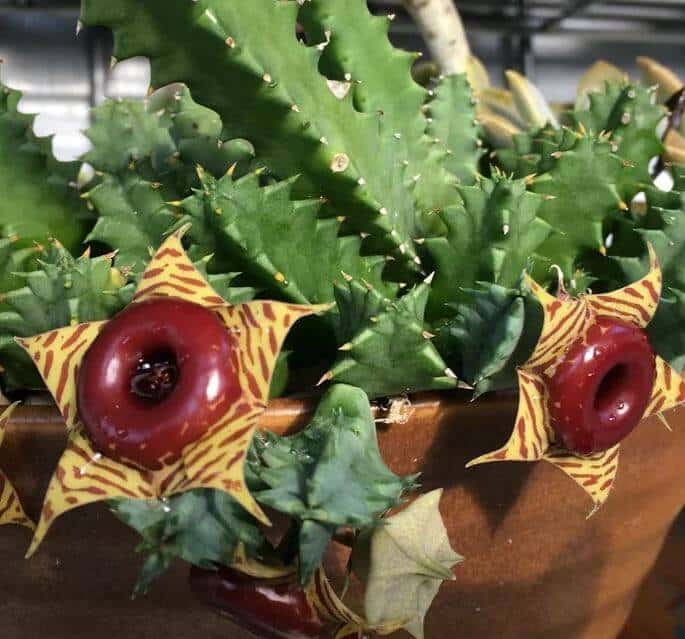Last Updated on April 20, 2023 by a Friendly Gardener
Natives of South Africa, Zimbabwe, Botswana, Namibia, and Mozambique, the Huernia Zebrina are popularly known as Owl Eye Cacti or succulents. They are known and appreciated for their unique blooms which feature star-shaped flowers with five points in yellow and red hues. This plant flowers in summer. Stems are four-sided and feature soft teeth along their edges.
Members of the Apocynaceae family, these cacti are low-growing perennial plants that do not become particularly large as they do not grow much taller than eight inches nor spread more than six inches. Because they require a warm climate, they do very well when cultivated indoors. If you travel or have limited time for houseplants, this lovely cactus is an ideal choice as it survives with very little water. They are exceptionally easy to cultivate.
Other popular names for these succulents include the Zebra-striped Huernia, the Carrion Flower, the Lifesaver plant, the Lifesaver Cactus, Little Owl Eyes, or Owl Eyes succulent. A few Owl Eye cactus varieties have blooms that emit very pungent fragrances that have been compared to the smell of Carrion. They attract primarily flies which are the vehicle for the plant’s pollination, so keep this in mind when selecting a species for indoor cultivation.
Species include:
- Huerniazebrina
- Huernia Zebrina subs. Magniflora. This subspecies has thicker and longer stems. Blooms vary in color, pattern, and size.
- Huernia Zebrina subs. Insigniflora. This subspecies features a purplish reddish annulus with flower lobes that range from ivory to pink. They may appear without marks or are faintly mottled. Stems are grey-green and the characteristic teeth along the edges are smaller.
Owl Eye Plant Care

The Owl Eye succulent requires very little water, less light than other cacti, and little to no pruning, and yet proper cultivation rewards gardeners with eye-catching flowers.
Soil
This plant’s native habitat is rocky, dry land where shrubs are prevalent with loamy soil or even calcrete soil which is calcium-rich. When cultivating indoors, the soil should be exceptionally well-draining. The Owl’s Eye plant would do well to be planted in a blend of one part sand, one part organic mulch, and two parts perlite. Perlite can be substituted with pumice and the mulch can be substituted with peat moss. This growing medium blend will guarantee proper drainage. Ideally, soil pH should measure six.
Light
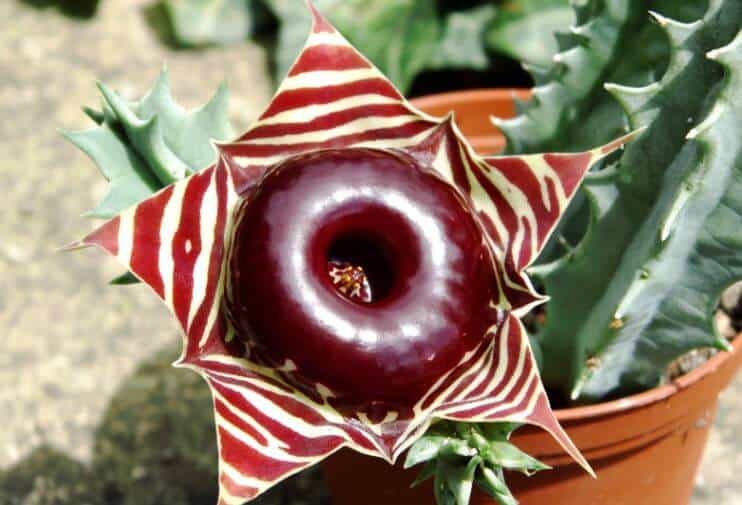
This is a succulent that does not enjoy excessive or harsh direct sun exposure. When the Eye Owl’s cactus plant receives too much light, it will maintain a deep red to a purple hue as opposed to green. In South African natural habitats, you will find these plants growing beneath vegetation or shrubs, so they should be provided with partially shaded spots and some bright indirect light. For this reason, they are ideal for indoor cultivation.
Water
As succulents, the Owl’s Eye cactus does not require much water. It is highly sensitive to overwatering and is susceptible to developing root rot. The soil bed and root system should be allowed to dry out completely before the plant is rewatered. In the warmer spring and summer seasons, they may need more frequent watering, while in their dormant season in fall and winter, watering should be reduced.
Temperature
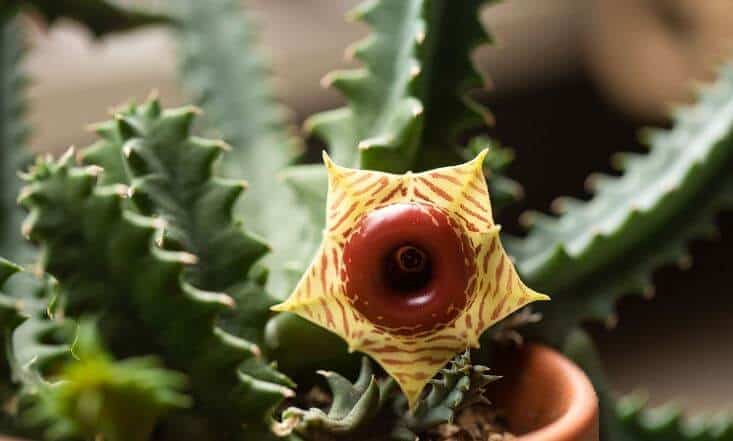
The Huerniazebrina requires a warm climate to thrive, so they should be in spots with temperatures ranging from 50° to 80° F. They should not be exposed to extreme cold or freezing temps. To boost your plant’s general health, place them outside during the growing season. Root systems do die back when they enter the dormant season.
Feeding
As a succulent, the Owl’s Eye Cactus does not require frequent feeding. However, to boost your plant’s growth habits consider a monthly feeding in the spring and summer. Use a liquid fertilizer specifically formulated for succulents with an NPK of 15-15-15. It is recommended that you dilute the fertilizer to half of its strength. Cease feeding as the summer nears its end as you do not want your plant to grow when it should be entering its rest period.
Pruning
Pruning is not required and may only be needed if you want to reduce the plant size or shape your plant.
Repotting the Owl Eye Cactus Plant
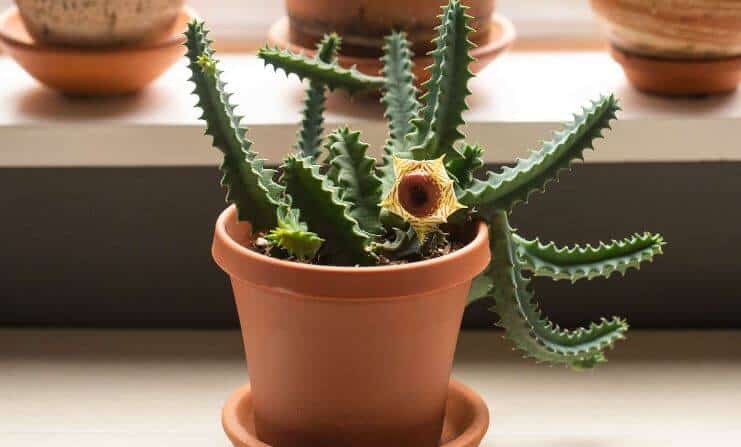
When choosing to repot your Owl Eye cactus, select a clay or terracotta container to aid in wicking away excess moisture. Containers should be shallow so that the soil medium can dry out completely before watering anew.
Owl Eye Cactus Propagation
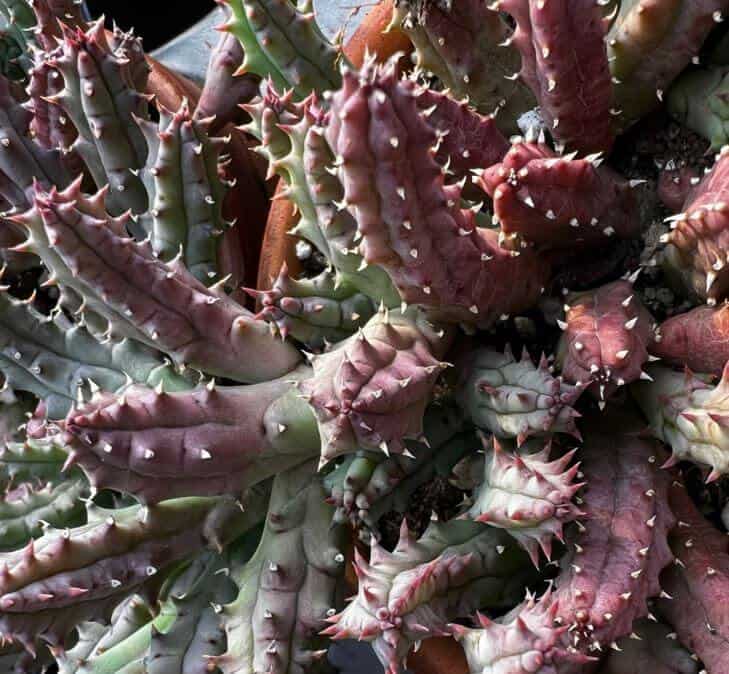
These succulents can be propagated easily using cuttings. Remove cuttings from a healthy plant and place them in a dry location for 24 hours to allow cut ends to callous over. Positioned callous ends in the appropriate soil mix and locate your cuttings in a place with generous bright, but indirect light. Avoid watering until roots develop which will require two to three weeks.
Owl Eye Cactus Problems
Other than the development of root rot or black rot from overwatering, the Huerniazebrina is susceptible to common houseplant pests including aphids, thrips, spider mites, and mealybugs. Mealybugs are particularly attracted to this stapeliad. A stapeliad is a spineless, low-growing, stem succulent plant that uses flies for pollination purposes. The blossoms of these plants often emit a smell similar to rotting meat to attract flies for this reason.
If you find evidence of a pest infestation such as webbing or the typical white cottony deposits left by mealybugs, clean your plant with a solution that is 30% water and 70% isopropyl alcohol by soaking a cotton ball or pad and rubbing.

